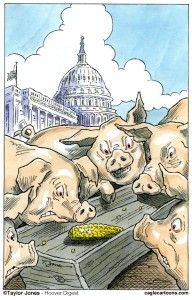Deregulating ‘earmarks’ saved schools, didn’t hurt poor
By Wayne Lusvardi
Deregulation got a bad rap in California ever since it was wrongly blamed as causing the Energy Crisis of 2001 and the San Diego Blackout of 2011. But a new study by the Rand Corporation, titled “Deregulating School Aid in California: How Districts Responded to Flexibility in Tier 3 Categorical Funds in 2010-11,” reports that deregulation saved public schools in California from 2007 to 2010.
Starting in 2007, the California legislature under Assembly Bill ABX-4-2 deregulated $4.5 billion in school district budget “earmarks” at the same time they cut overall school funding. It worked!
Most of the formerly politically earmarked money was shifted into the general fund of local school districts to protect core teachers from layoffs and was not used to pad administrative salaries. Neither did unions or parent groups dominate the decision making over these “flex” funds. The only exception was the Los Angeles Unified School District (LAUSD), which tried to protect district administration costs, according to the Rand Corporation report. And deregulation did not disproportionately affect programs for high-need students, despite hysteria that it would.
The Rand Corporation surveyed chief financial officers from 921 school districts across the state. Rand found that the change in all school revenue sources including earmarks from 2007 to 2010 was a reduction of 7.7 percent, reflecting $846 per student. This has to be put in context that the K-12 school budget grew by $1,746 per student, or over 20 percent, from 2006 to 2007 during the Housing Bubble.
Tier 3 Categorical Programs: Political Pork Earmarks
What the legislature deregulated was what is called “Tier 3 Categorical Programs.” This is a bureaucratic sugar coated term for low priority political earmarks or restricted funds. By restricting the funds for special purposes, state legislators bought votes and political patronage from the beneficiaries. Another term for “categorical” funds might be “political pork.” Pork is a term deriving from when salt pork was distributed in barrels to slaves prior to the Civil War (Safire’s Political Dictionary).
The California Education Budget includes three tiers of “Categorical Funding” in descending priority as shown below:
CATEGORICAL STATE SCHOOL FUNDING (Source: Rand Corp.)
| Tier | Funding Level 2009 | Representative activities |
| 1 | $6.58 billion | Special education, K-3 class size reduction, after school programs, home-to-school transportation, child nutrition |
| 2 | $0.25 billion | Student assessments, charter school facility grants, apprenticeship and foster youth programs, adults in correctional facilities, agricultural vocational education, high speed network |
| 3 | $4.53 billion DEREGULATED |
Deferred building maintenance, counseling, art and music, physical education, American Indian Education Centers, American Indian Early Education, oral health assessments, staff mentoring |
In other words, in the Tier 3 category, funds were specifically restricted to targeted beneficiaries: building trade workers, school psychologists, art and music teachers, Indian tribes, dentists, physical education instructors, etc. By restricting the funding to these groups, their salaries became politically protected from being cut back by local school boards. Interestingly, teacher dismissals were one of the least funded items in the Tier 3 category.
From 2007 to 2009, local school districts widely claimed in the media that core teachers and arts and music teachers would be laid off if categorical funding were cut. But according to the Rand report, no core teachers were affected by deregulating categorical funding. And whether art or music teachers were laid off was a decision of local school districts that had to decide between, say, art teachers and staff mentoring or deferred building maintenance.
Deregulation did not cut the total apportioned $4.5 billion from Tier 3 Categorical programs. It only cut about 20 percent of Tier 3 funding, thus reducing the total funding level to $3.62 billion. And instead of protecting funding levels for “pet” programs that state legislators could buy votes with, it merely made the remaining funding discretionary. Local school districts, not state legislators, could choose what to do with the funding. Categorical programs exist so that state legislators can claim that they “brought the bacon home” to their local constituents.
Where Did the Savings Go?
According to the Rand report, most of the cost savings went into shifting funds into the general fund of school districts to remain solvent after the state budget crisis resulted in state funding cutbacks.
Gov. Jerry Brown has proposed expanding deregulation of categorical funding for public schools to $7.1 billion of the state school budget.
Deregulation has gotten a bad rap in California. But it might be a partial alternative to raising taxes, as proposed by Gov. Brown and billionaire Molly Munger in their initiatives for November 2012.
Related Articles
AG’s low-key Vergara appeal has damage-control vibe
Without fanfare, Attorney General Kamala Harris appealed the Vergara decision throwing out state teacher tenure and job-protection laws late Friday
Video: More choices means a better education
CalWatchdog.com’s Brian Calle talks to Superintendent Liz Fagen about how a robust program to offer parents and students choices about
VIDEO: Can “Parent Trigger” Fix Our Schools?
With the invention of the “parent trigger” there’s a new tool that parents can use to fix their broken school





